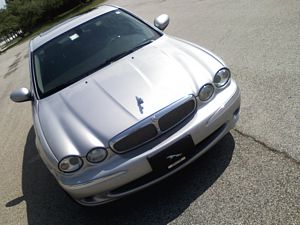















Jaguar X-Type |
|---|
|
| External Links |
|---|
| Wikipedia: Jaguar X-Type |
| Page Sections |
|
History
Article Index Photographs Documents |
History
The following section is an excerpt from Wikipedia's Jaguar X-Type page on 7 November 2017, text available via the Creative Commons Attribution-ShareAlike 3.0 Unported License.
The Jaguar X-Type is an entry-level luxury car that was manufactured and marketed by Jaguar Cars from 2001 to 2009 in a single generation under the internal designation X400. Manufactured at the Halewood Assembly Facility near Liverpool,
the X-Type was developed during Jaguar's tenure in the Premier Automotive Group (PAG) of Ford Motor Company — and was based on a modified version of the Ford CD132 platform, shared with the contemporary Ford Mondeo.
The smallest of the Jaguar model range, the X-Type was marketed in notchback saloon and estate variants, and was the first estate manufactured in series production by the company.
The Jaguar X-Type, codenamed X400, was launched in Summer 2001 as Jaguar's first compact executive car since the Jaguar Mark 2 of 1959. The X-Type was one of the last to be styled under the supervision of Geoff Lawson, with Wayne Burgess as principal designer.
The four door saloon was launched in 2001, and in January 2004, the five door estate joined the range, with production of both versions ending in July 2009. The estate was officially marketed as the "Sportwagon” in the United States and was the first Jaguar model designed by Ian Callum.
Initially, the X-Type was only available with all wheel drive, and either a 2.5 litre or 3.0 litre V6 petrol engine. In 2002, an entry level 2.1 litre V6 front wheel drive model was added. All three engines were available with either five- speed automatic or five speed manual transmissions. The X-Type grille was slightly modified for both the 2004 and 2006 model years.
The X-Type was based on a modified version of the Ford CD132 platform shared with the Ford Mondeo. The X-Type was initially offered as all-wheel drive only and mated to a 2.5 litre and 3.0 litre AJ-V6 petrol engine.
The Jaguar AJ-V6 engine design is unique to the Jaguar X-Type; one notable addition is the use of variable valve timing. The X-Type's petrol engine is also set apart by the use of SFI fuel injection, four valves per cylinder and featured fracture split forged powder metal connecting rods, plus a one piece cast camshaft, and has direct acting mechanical bucket (DAMB) tappets.
In 2003, the X-Type was also offered in front-wheel drive with the introduction of Jaguar’s first four-cylinder diesel engines (based on the Ford Duratorq ZSD unit from the Mondeo and Transit), and with the smaller 2.1 litre petrol V6. The six speed automatic transmission supplied on the later 2.2 litre diesel models includes Jaguar Sequential Shift.
 |
Subject: Jaguar X-Type
Photographer: Bill Crittenden Location: Illinois 
Date: 2009 View photo of Jaguar X-Type - 257KB |
| Date | Document Name & Details | Documents |
|---|---|---|
| Febuary 2002 | On-scene Investigation / Vehicle to Vehicle 2002 Jaguar X type 3.0 National Highway Traffic Safety Administration | PDF - 722KB - 18 pages |
| 27 January 2005 | Safety Compliance Testing for FMVSS 401: Interior Trunk Release 2005 Jaguar X-Type National Highway Traffic Safety Administration | PDF - 495KB - 17 pages |
| 29 August 2005 | Vehicle Safety Compliance Testing for FMVSS 208, Occupant Crash Protection; FMVSS 212, Windshield Mounting; FMVSS 219, Windshield Intrustion (Partial); FMVSS 301, Fuel System Integrity 2005 Jaguar X-Type Passenger Car National Highway Traffic Safety Administration | PDF - 21.7MB - 353 pages |
| classified date 2007 | Special Crash Investigation Report Case Vehicle: 2005 Jaguar X-Type, 4-door sedan National Highway Traffic Safety Administration | PDF - 7.4MB - 128 pages |
| Date | Article | Author/Source |
|---|---|---|
| 27 May 2004 | Jaguar x-type Reaches Out to Tastemaker Audience Through Music-Based Lifestyle Program | Miles High Productions |
| 5 January 2006 | DAMAC Properties Unveils DSF 2006 Mega-Promotion | DAMAC Properties |
